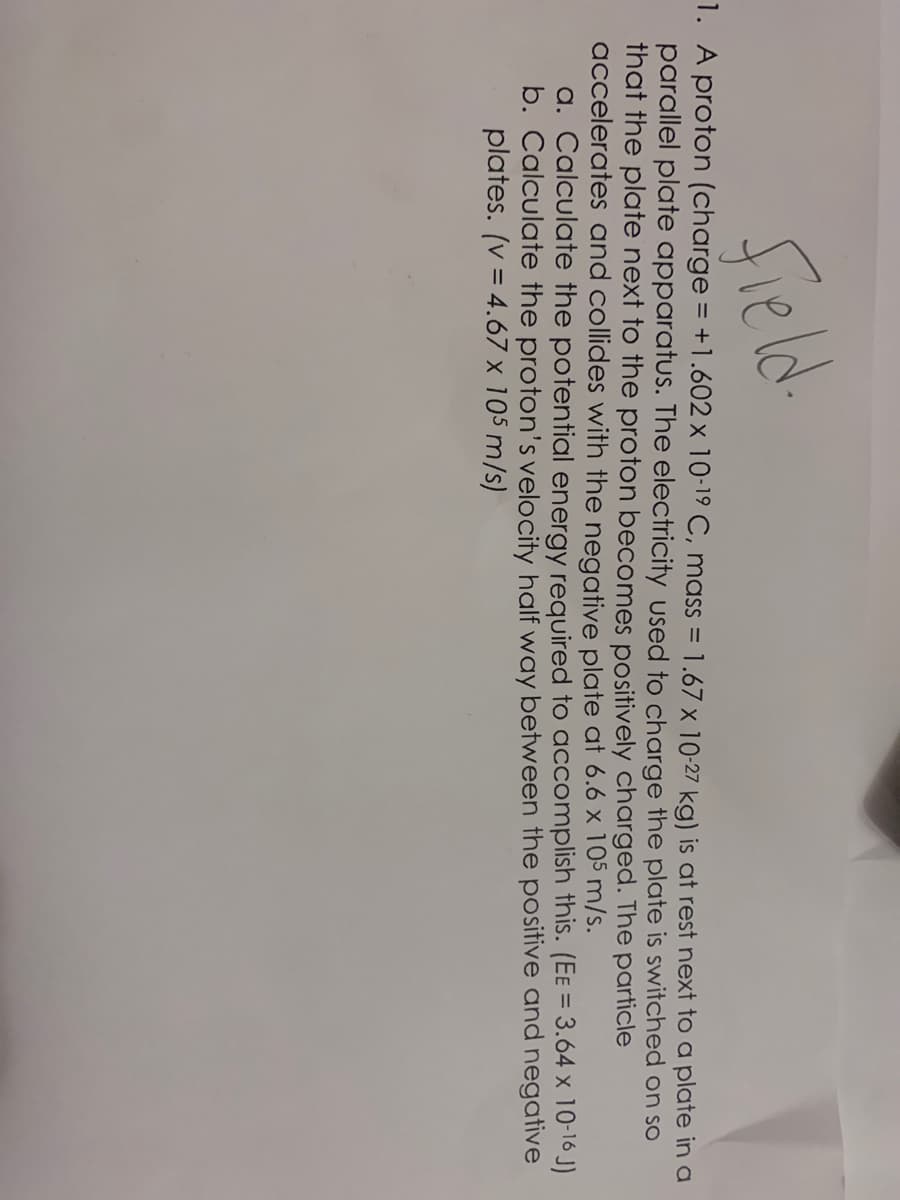A proton (charge = +1.602 x 10-19 C, mass parallel plate apparatus. The electricity used to charge the plate is switched on so that the plate next to the proton becomes positively charged. The particle accelerates and collides with the negative plate at 6.6 x 105 m/s. a. Calculate the potential energy required to accomplish this. (EE = 3.64 x 10-16 J) b. Calculate the proton's velocity half way between the positive and negative plates. (v = 4.67 x 105 m/s) 1.67 x 10-27 kg) is at rest next to a plate in a %3D
A proton (charge = +1.602 x 10-19 C, mass parallel plate apparatus. The electricity used to charge the plate is switched on so that the plate next to the proton becomes positively charged. The particle accelerates and collides with the negative plate at 6.6 x 105 m/s. a. Calculate the potential energy required to accomplish this. (EE = 3.64 x 10-16 J) b. Calculate the proton's velocity half way between the positive and negative plates. (v = 4.67 x 105 m/s) 1.67 x 10-27 kg) is at rest next to a plate in a %3D
College Physics
10th Edition
ISBN:9781285737027
Author:Raymond A. Serway, Chris Vuille
Publisher:Raymond A. Serway, Chris Vuille
Chapter16: Electrical Energy And Capacitance
Section: Chapter Questions
Problem 7P: Oppositely charged parallel plates are separated by 5.33 mm. A potential difference of 600. V exists...
Related questions
Question

Transcribed Image Text:field
1. A proton (charge = +1.602 x 10-19 C, mass =
parallel plate apparatus. The electricity used to charge the plate is switched on so
that the plate next to the proton becomes positively charged. The particle
accelerates and collides with the negative plate at 6.6 x 105 m/s.
a. Calculate the potential energy required to accomplish this. (Ee = 3.64 x 10-16 J)
b. Calculate the proton's velocity half way between the positive and negative
plates. (v = 4.67 x 105 m/s)
1.67 x 10-27 kg) is at rest next to a plate ina
Expert Solution
This question has been solved!
Explore an expertly crafted, step-by-step solution for a thorough understanding of key concepts.
Step by step
Solved in 2 steps

Knowledge Booster
Learn more about
Need a deep-dive on the concept behind this application? Look no further. Learn more about this topic, physics and related others by exploring similar questions and additional content below.Recommended textbooks for you

College Physics
Physics
ISBN:
9781285737027
Author:
Raymond A. Serway, Chris Vuille
Publisher:
Cengage Learning

Physics for Scientists and Engineers with Modern …
Physics
ISBN:
9781337553292
Author:
Raymond A. Serway, John W. Jewett
Publisher:
Cengage Learning

Physics for Scientists and Engineers
Physics
ISBN:
9781337553278
Author:
Raymond A. Serway, John W. Jewett
Publisher:
Cengage Learning

College Physics
Physics
ISBN:
9781285737027
Author:
Raymond A. Serway, Chris Vuille
Publisher:
Cengage Learning

Physics for Scientists and Engineers with Modern …
Physics
ISBN:
9781337553292
Author:
Raymond A. Serway, John W. Jewett
Publisher:
Cengage Learning

Physics for Scientists and Engineers
Physics
ISBN:
9781337553278
Author:
Raymond A. Serway, John W. Jewett
Publisher:
Cengage Learning

College Physics
Physics
ISBN:
9781305952300
Author:
Raymond A. Serway, Chris Vuille
Publisher:
Cengage Learning

Physics for Scientists and Engineers, Technology …
Physics
ISBN:
9781305116399
Author:
Raymond A. Serway, John W. Jewett
Publisher:
Cengage Learning
